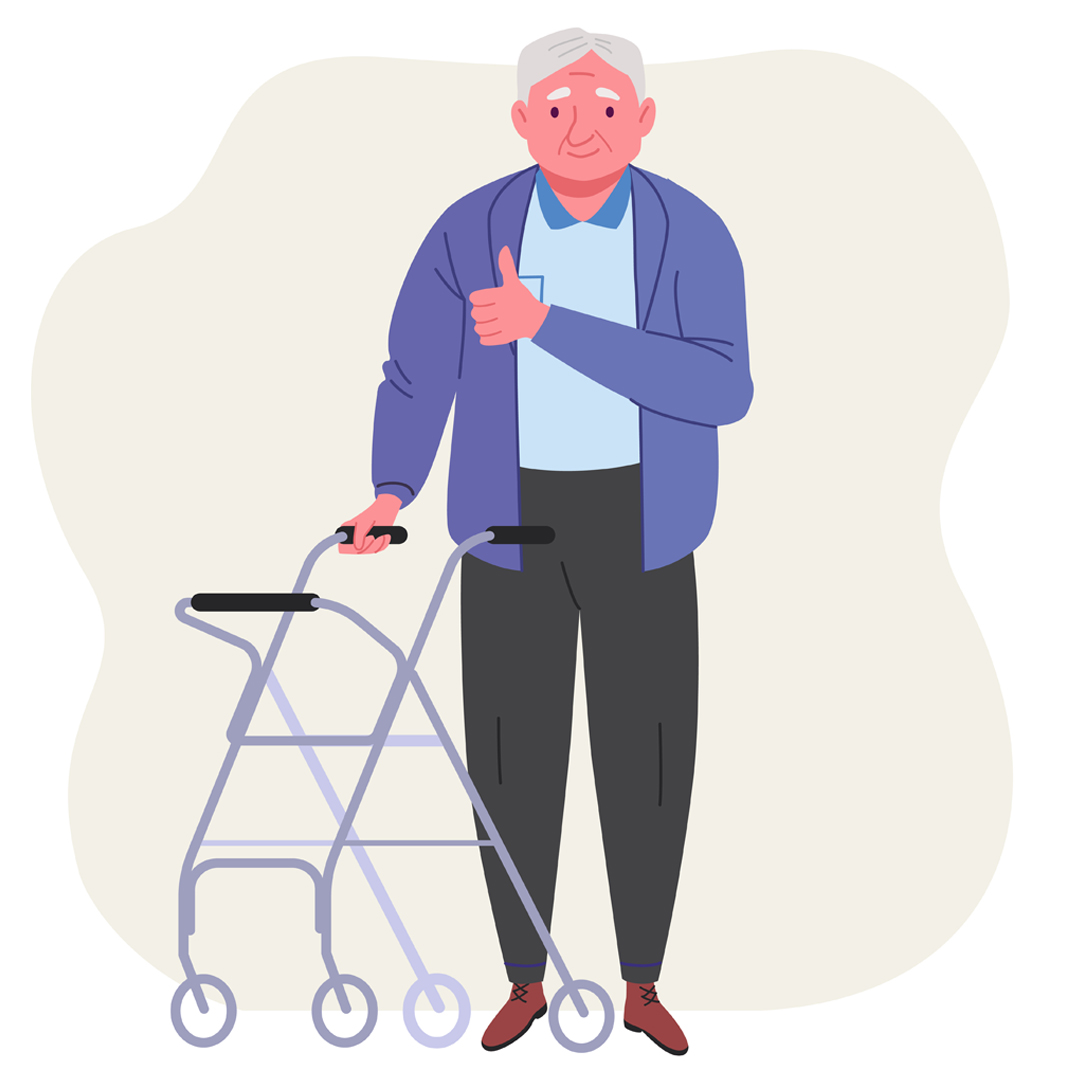How to Prevent Falls in Aged Care (& At Home)
Understanding fall risk factors | Key exercises | Home tweaks | Safety must dos
Posted 5th December 2023 | 7 minute read
By Jesse Gramenz Reviewed by Julie Dymock
Reviewed by Julie Dymock

More than 1 in 4 older people (65+) fall every year. So, what can aged care homes and seniors living at home do to prevent it? Let’s find out.
Understanding Senior Fall Risks
First up, let’s talk about what puts someone at risk for a fall. We're talking about things like weaker muscles, balance issues, and even home hazards that could put someone in a potentially dangerous situation. But even outside of that, it might be a resident's choice to go for walks where they might be at risk for falls.
Because of this, it's important to let residents have the dignity of taking risk as long as those risks are informed, and that staff are taking every precaution they can to minimise falls where possible.
Fall risk factors for seniors are varied and often interconnected. These factors can broadly be categorized into a) Personal factors and b) Environmental factors.
Personal Fall Risk Factors
Some personal fall risk factors for an elderly person can include:
Age-Related Physical Changes
Reduced muscle strength, decreased bone density, joint stiffness, and overall decline in physical fitness can affect balance and coordination.
Medical Conditions
Chronic diseases like arthritis, diabetes, heart disease, or neurological conditions such as Parkinson’s disease can affect a senior's mobility and balance.
Medication Side Effects
Some medications or combinations of medications can cause dizziness, dehydration, or sudden drops in blood pressure that can lead to falls.
Vision and Hearing Loss
Poor vision and hearing loss can prevent seniors from detecting hazards that could cause them to trip or fall.
Cognitive Impairment
Conditions like Alzheimer's disease or other forms of dementia can lead to poor judgment and difficulty with spatial orientation, increasing fall risk.
Balance and Gait Problems
Difficulty with walking and balance, often due to muscle weakness or neurological conditions, is a significant risk factor for falls.
Slow Reflexes
Delayed reaction times can prevent seniors from catching themselves if they start to fall, increasing the likelihood of injury.
Foot Problems
Painful foot conditions and poor footwear can affect stability and gait.
Environmental Fall Risk Factors
Some environmental fall risk factors for an older person can include:
Home Hazards
Loose rugs, poor lighting, cluttered floors, and lack of handrails & safety equipment in bathrooms can all contribute to falls.
Improper Use of Mobility Aids
Incorrect use of walkers, canes, or wheelchairs can lead to accidents.
Unsafe Clothing
Clothes that drag on the ground or shoes with poor grip can cause tripping or slipping.
Environmental Conditions
Icy footpaths, wet floors, uneven terrain, and other outdoor hazards can increase the risk of falls.
Understanding and mitigating these risk factors through a senior fall risk assessment can help prevent falls. This assessment typically involves a healthcare professional evaluating a senior's risk of falling by looking at their health conditions, medications, home environment, and overall physical and mental fitness. Based on this assessment, tailored solutions such as physical therapy, home modifications, or changes in medication can be suggested to reduce the risk of falls.
While it’s always best to get assessed face to face before making any major changes, let’s talk a little more about the types of recommendations you could expect to see as part of an assessment including exercise and modifications to your home environment.
Key Exercises to Stop Falls
When it comes to exercises, a broad consensus among experts suggests that older adults, particularly those at risk of falling, benefit from exercises that focus on balance, gait, and strength training2. Let's look at some specific programs and exercises backed by studies:
- Integrated Training Programs: These often include a mix of resistance training, core strengthening, and balance exercises. Such programs have been shown to effectively reduce fall risks3.
- Pilates and Tai Chi: These exercises emphasize controlled movements and core strength, which are key in maintaining balance. Pilates and Tai Chi have been particularly noted for their positive impact on balance control13.
- Balance Training: This can be done through T-bow and wobble board training, which challenges the body's balance and strengthens the muscles used to stay upright4.
- Aerobic and Stability Exercises: Aerobic step and stability ball training are excellent for improving overall fitness and balance, which are critical in fall prevention4.
- Adapted Physical Activities: Including Wii Fit training, which can be both engaging and effective in improving balance among seniors4.
- Combined Exercise Protocols: Studies have found that combining different types of balance and strength exercises is highly effective in reducing fall-related injuries. This benefit is significant even for those who are 80 years and older5.
By incorporating these exercises into regular routines, seniors can significantly improve their balance and reduce the risk of falls. It's important to note that the exercises should be tailored to the individual's capabilities and performed consistently for the best outcomes.
Clinical Manager Julie says:
“A study in 2020 showed that by engaging in phyisical activity, you can actually reduce cognitive decline by a third. That's huge! There's so many different exercises you can do throughout the day that don't have to be in a gym. Check out page 19 of this PDF where you can even do exercises while you're waiting for your kettle to boil for a cup of tea!” |
Aged Care's Part in Fall Prevention
Aged care facilities and providers play a significant role in fall prevention through:
- Environmental Audits: Regularly checking living spaces for hazards and making necessary modifications.
- Educational Programs: Teaching seniors about fall risks and prevention strategies.
- Exercise Programs: Implementing group exercises tailored to improve balance, strength, and mobility.
- Personalized Care Plans: Creating individualized care plans that include fall prevention strategies based on each senior’s risk factors.
Fall Prevention Exercises at St Vincent’s aged care
Residents at St Vincent's Care Carseldine experienced a 40% reduction in falls after participating in a 52-week exercise program designed by Encara Health.
The program, based on the Otago Falls Prevention program, involved both group and individual sessions, focusing on improving mobility and quality of life for elderly residents, especially those recovering from hip fractures. The program not only helped in rehabilitation but also in preventing future falls, which are a significant cause of injury and death in older Australians.
For more details, read the full article here.
Home Tweaks to Reduce Risk of Falls
There's an array of home modifications seniors can make that can reduce risk of falls and make their home a safer place to be.
Some key and common changes include:
- More Supports in Tricky Areas: Install grab bars and railings in critical areas like the bathroom and along stairs. A shower seat and an adjustable handheld shower head can make your evening shower a bit safer.
- Improved Lighting: Adequate lighting is crucial. Replace any burnt-out bulbs with bright, non-glare LED lights to ensure all areas are well-lit, reducing shadows and glare that can cause missteps.
- Create Resting Points: Having a sturdy chair in the bedroom or hallway allows seniors to sit while dressing or to take a break if they feel fatigued while moving around the house.
- Clutter-Free Paths: Ensure that walkways and staircases are free of clutter, cords, or loose rugs that could trip someone up.
- Optimize Storage: Keep frequently used items within easy reach, ideally between waist and shoulder height to avoid the need to stretch or bend down.
- Consider a Medical Alert System: These systems can monitor movement and send alerts if a fall is detected, offering an additional layer of safety.
Some less common tweaks that can also be super helpful:
- Create color contrast between floors, walls, and furniture to improve depth perception.
- Apply non-slip wax to floors and use non-skid mats under rugs.
- Replace knobs with lever-style handles for easier grip and use.
- Consider smart home devices like voice-activated lighting or thermostats.
Personal Safety Must-Dos for Seniors
While changing your environment is a big part of preventing your risk of falls, here are some additional checks you can do to reduce your risk of falling:
- Regular Vision and Hearing Checks: Impaired vision or hearing can increase fall risk.
- Medication Review: Some medications can affect balance, so a regular review can help manage these side effects.
- Safe Footwear: Non-slip, well-fitting shoes are essential.
- Emergency Contacts: Keep a list of emergency contact numbers in an accessible place.
For Australians, My Aged Care offers subsidised support services, which can be used for home modifications. Under this program, seniors can receive assistance with chores and modifications that help them stay safe and independent at home2.
Parting Thoughts
With the rate of falls so high among the elderly, knowing about the different strategies that the experts implement to minimize their risk can be extremely helpful. Use the tips above and give yourself a little more peace of mind when it comes to your loved one's safety.
Still have questions?
CHAT TO OUR AGED CARE EXPERTS
- Home
- Residential Aged Care
- How to Prevent Falls in Aged Care (& At Home)
Helpful Information
.jpg)
How to Talk About Aged Care With Your Parents

Staff and Qualifications
.jpg)
